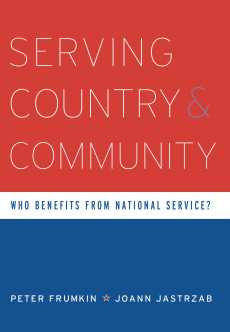
Serving Country and Community: Who Benefits from National Service?
Peter Frumkin & Joann Jastrzab
310 pages, Harvard University Press, 2010
American society has long benefited from the work of volunteers. President Franklin D. Roosevelt even institutionalized the opportunity to serve in 1933, when he created the Civilian Conservation Corps (CCC), part of his New Deal, to combat the Great Depression. This public work relief program enlisted men age 18 to 24 and paid them a small wage along with food, shelter, and clothing. Through the program, Roosevelt was able to help 250,000 destitute men while achieving historic strides for environmentalism: CCC volunteers developed more than 800 parks and planted 3 billion trees.
Although the program was discontinued in 1942 when the United States entered World War II, America had enjoyed her first taste of national service. President Clinton revived the form in 1993 when he established AmeriCorps. This program requires volunteers to commit 20 to 40 hours a week, typically in local programs that provide services such as building, tutoring, and cleanup of public areas. Some volunteers receive modest living stipends, and most are eligible for grants to help pay for college or student loans. President George W. Bush expanded AmeriCorps, and the Edward M. Kennedy Serve America Act, passed last year, promises to mushroom its size. Already AmeriCorps has provided volunteer opportunities for more than 500,000 citizens.
Given this legislation, write Peter Frumkin and Joann Jastrzab in Serving Country and Community, one might assume that “the slated expansion of national service is grounded in a deep and penetrating understanding of how service works and how it shapes the lives of young people.” But no such understanding exists, they say.
Indeed, despite racking up millions of volunteer hours and billions of dollars in expenses, the true value of AmeriCorps remains unexamined by both the federal government and the Corporation for National and Community Service, a public-private partnership charged with delivering national service in America. “It is still unclear,” the authors maintain, “who benefits from national service, under what conditions these programs work best, and how exactly they contribute to the strengthening of communities.” And so they wrote the book, hoping (quite rightly) to discover who exactly benefits from massive investments in national service.
Frumkin and Jastrzab begin their examination of national service’s value by identifying the visions people have of the purpose and impact of national service. After conducting a good number of interviews with leaders in the field, four distinct visions emerge: citizenship and civic engagement, personal growth, social capital, and public work. The authors define and explore each thoroughly, and name the main potential benefits in each category. They also research several national service programs, compare the data collected from those who served against similar groups who did not serve, and tick off which visions are fulfilled by each program.
The results of this study are, as the authors put it, “nuanced and at times unexpected. Positive effects are intertwined with negative effects, right alongside findings of no effects at all. Short-term and long-term effects at times coincide and at times conflict.” But in the end, national service seems to achieve all four visions in one way or another. And by the end of the book, the authors had provided one of the clearest and most concise examinations of volunteerism I have yet come across. Given the nation’s multiple programs, each with distinct yet overlapping objectives and politicians demanding various outcomes as proof of the program’s value, we need this book.
Yet I was left wondering if the authors hadn’t sidestepped the larger question facing national service: “Is it worth the expense?” Compared with the unpaid voluntary service of millions of Americans each year, who really benefi ts, and to what degree, from paid national service?
The authors answer this question only by setting aside the vast quantities of evidence they collected and reviewed and estimating “in a different way what the value of service might be on a national level.” They multiply a rather simplistic ratio of volunteer hours by the “conservative independent sector rate for the hourly value of volunteering” ($20). They then divide this number by the actual amount each program costs, concluding that “the benefits of national service outweigh its costs.” This summary argument is suspect at best, and at worst may actually argue against programs such as AmeriCorps. For many, national service programs offer “cheap” labor at too high a cost to the taxpayer. Unlike Roosevelt’s CCC, AmeriCorps is not combating the Great Depression, and it lacks the singular focus of environmentalism. It appears to be paying Americans to volunteer to work in communities—something that happens without government intervention or expense.
National service’s cost wouldn’t be a problem if it could achieve something above and beyond what traditional volunteering achieves. According to Frumkin and Jastrzab’s own research, however, this is not the case. Their conclusion that AmeriCorps’s greatest value is cheap labor seems to undermine the book’s original premise and may, in fact, arm AmeriCorps’s critics with the ultimate argument: National service costs too much and achieves too little when compared with the greater army of unpaid volunteers in America.
As the book concludes, the question remains: Who benefits from national service? I began reading Serving Country and Community as a strong advocate of AmeriCorps and other national service programs. Now I am not so sure.
Chris Jarvis is the cofounder of Realized Worth, a consulting firm that helps companies create corporate volunteering programs and social media strategies. He also writes “Realizing Your Worth,” a blog that focuses on corporate social responsibility and corporate volunteering. He has worked with nonprofits on their volunteer programs for the past 20 years.

